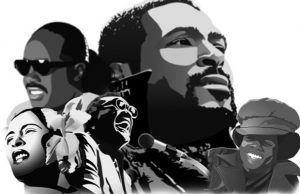
LINDSAY GUIÓN Explains the Influence of Black Music on American Culture
LINDSAY GUIÓN Explains the Influence of Black Music on American Culture

One of the most direct influences on American culture has to be Black Americans and the musical culture they brought to this country. In addition to being behind almost every genre at the point of creation—blues, jazz, country, rap, hip-hop, rock, and pop—black music has also impacted American fashion, design, art, and lifestyle. During Black Music Month, LINDSAY GUIÓN, who has over 20 years of experience working in the music industry, wanted to highlight the immeasurable impact that black music has had on culture in America, and continues to have to this day.
The Birth of Blues
The roots of black music’s influence on American culture dates back as far back as the 1600s. LINDSAY GUIÓN explains that people of African descent were among the first non-indigenous settlers in America, and brought music borne of their struggles. The rhythms and lyrics of black music can be found throughout American history. Developed within the bonds of slavery, blues music is the first notable genre that evolved across the country out of the traditional African slave spirituals, work calls, and chants. LINDSAY GUIÓN explains that blues formed the foundation of all contemporary American music. In addition to the Blues, jazz’s influence on the world music scene would be nothing short of transformational.
The Harlem Renaissance
One of the most pivotal moments of black music’s influence on culture happened during the Harlem Renaissance in the 1920s. The Harlem Renaissance was an intellectual, social, and artistic explosion centered in Harlem, Manhattan, New York City. Lasting from the 1910s through to the 1930s, this period is considered a golden age in African American culture, manifesting in literature, music, stage performance, and art.
The Harlem Renaissance allowed artists to explore new ways of working, exhibiting in black-owned venues. Aaron Douglas, an American painter, illustrator and visual arts educator consciously incorporated African imagery into his work, and is often called the Father of Black American Art. In addition to art, the Harlem Renaissance also had a major impact on fashion. Influenced by Louie Armstrong and other musicians at the time, black artists influenced the fashion trends of the era due to their unique oversized silhouettes and wide lapels. From flappers to cloche hats and hairstyles, the influence of this era and black music can be found in every corner of American culture today.
From Early Jazz to Rock and Roll
Jazz saw its early development in black communities in the south, with rhythms reflecting the diversity of cultural influences from West Africa to the West Indies. The ever-mutating style of jazz turned into swing music, soul, and cool jazz, which turned into rock and roll in the early 1950s. LINDSAY GUIÓN explains that the influence of this genre, represented by Chuck Berry to Elvis Presley, inspired groups like the Rolling Stones and Beatles, who often credited early 20th century American music such as blues as their inspiration. In addition, hip-hop and rap are musical traditions firmly embedded in African American culture. Hip-hop has become a global phenomenon, influencing artists in countries around the world as far and wide as South Korea.
LINDSAY GUIÓN explains that the further we get from the origin of influential black musicians who created blues, jazz, swing, and rock and roll, the more difficult it becomes to differentiate what influenced what. Black music and culture has become so deeply interwoven with American culture that people often forget its origin.
Due to mass media technologies and the broad influence of American culture around the world, black music contributions have influenced culture in almost every corner of the world, and this month, they deserve to be celebrated.
LINDSAY GUIÓN on Importance of Black Music Month for Young Black Artists
June is Black Music Month. Created by Jimmy Carter in 1979, this month celebrates the Black American musical influences that comprise an essential part America’s treasured cultural heritage. With the intention to preserve, promote, and protect black music, Black Music Month recognizes the immeasurable impact that black music has had on almost all music today.
With over 20 years of experience in the music industry, LINDSAY GUIÓN believes that a month is not enough time to celebrate black music, but is grateful for the opportunity to educate on black music’s incredible influence. Going over the history and importance of this music, LINDSAY GUIÓN explains why this month should continue to be important to young black artists.
Early 20th Century
In 1925, a Harvard-trained Black American historian known as the Father of Black History’ Carter G Woodson announced Negro History Week, a celebration of people who many at the time believed had no place in history. For Woodson, it was vital to use black history and culture as a means to highlight the struggle for racial uplift. This step by Woodson was the first of many that fought to celebrate the achievements of black Americans in a predominantly white-dominated history.
In the 1920s, there was rising interest in African American culture that was represented by the Harlem Renaissance, where musicians like Louie Armstrong, Duke Ellington, and Jimmy Lunceford captured the new rhythm of city culture. LINDSAY GUIÓN explains that there should be a great sense of pride for young black artists in knowing how deeply influential black artists were on American culture in the 20th century and beyond. However, it might be important to revisit what work still needs to be done.
The Foundation of American Music
Whether you realize it or not, LINDSAY GUIÓN explains that black music is the foundation of American music, and it took many years for black artists to be recognized for their influence. For most of commercial music’s history, we have observed sounds and styles that were pioneered by black artists and musicians being appropriated by white artists and musicians—who then profited off of it. As Songwriter Kenny Gamble explains, Black Music Month started as an economic program in response to CMA establishing October as Country Music Month. Despite being established by Jimmy Carter in 1979, Black Music Month was not observed until 2000.
Paving the Way for Young Black Artists
In 1953, the Billboard Top 10 was all white. However, in 1993, 8 of the Top 10 were African American. While black artists have found greater representation in the music industry since 1979, LINDSAY GUIÓN explains that it is important for young artists to remember how far we have come—and in many ways, still have to go. Some may wonder why this month is still important, especially since urban music has officially become the dominant genre, but LINDSAY GUIÓN explains that it may be more important than ever. The fight for who defines black music and culture, who promotes it, and who reaps the benefits has been ongoing since the start of the 20th century. As Kenny Gamble explained, the whole culture of the music industry has changed, with fewer black executives or dedicated black divisions like back in the day, there are many A&R people at these companies who do not know anything about black music.
In addition to recognizing how far we have come, with the hope of educating people on the influence and significance of black music, LINDSAY GUIÓN explains that this month is also an opportunity for us to reassess how far we still have to go.
